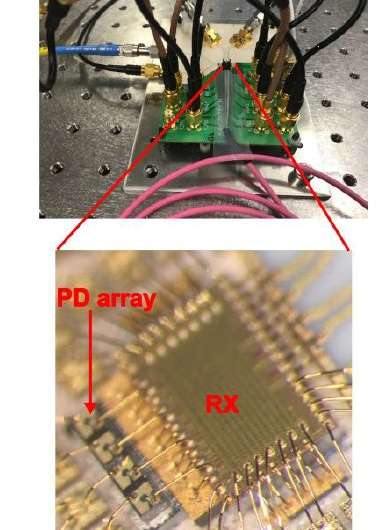IBM reveals novel energy-saving optical receiver with a new record of rapid power-on/off time

With the increasing popularization of datacenters and other bandwidth hungry interconnect applications, today's bandwidth growth of short-distance optical networks demands data transmission speeds of more than 100 Gb/s, calling for the development of energy-efficient, multi-channel optical links with fast data transfer rates.
Based on complementary metal-oxide-semiconductor (COMS) technology—a standard low-cost, high-volume chip manufacturing technique used for most processors and chips today—a group of researchers from IBM Research in Zurich, Switzerland, together with a consortium working under the EU-funded project "ADDAPT," have demonstrated a novel optical receiver (RX) that can achieve an aggregate bandwidth of 160 Gb/s through four optical fibers. This is not only the fastest data transmission speed to date, but the newly developed optical receiver also features the link power-on/off functionality and can wake-up and achieve phase-lock in eight nanoseconds, the shortest switch time in record. They will present their innovation at OFC 2018, 11-15 March, San Diego, California.
According to the researchers, the rapid power-on/off feature will enhance link utilization and greatly reduce energy consumption on a chip or in an optical interconnect system. Unlike many commercial optical transceivers that are always powered on regardless of transmission activity, the power here would only be used when data packets are transmitted through the optical link. The novel design, packaged with an 850-nanometer photodiode array, targets low-cost VCSEL-based optical links for datacenter interconnects.
"This is the first optical an receiver that combines high-speed data transmission rate and rapid power-on and off functionality while being extremely low lower in the 'power-on' state (about 88 miliwatts)," said Alessandro Cevrero, the primary author of the paper and a scientist of IBM Research Lab, Switzerland. Today, link utilization in datacenters is less than ten percent for 99 percent of the links. This means only ten percent of the links' work time is actually used for transmitting user data, while the rest of the time is wasted by sending idle data packets that missing information. To improve power efficiency in optical interconnect system, the researchers developed the rapid on/off functionality for the receiver, so that links can be powered off during idle time and powered back on when the data is ready to be transmitted.
"Our design, for the first time, allows for the on/off switching of and optical link on a per-packet basis," Cevrero said. The switch-on time is only eight nanoseconds, which is shorter than the average length of time for an individual data packet in a typical network protocol transmitted at a speed of 160 Gb/s. "There were previous scientific attempts to turn off the links when there is no data, however the timescale to switch on and off the link was orders of magnitude longer than that of an individual data packet. To achieve shorter power-on, time at a very high data transmission speed is the key challenge."
To address this, Cevrero's team designed an optical receiver with four identical channels associated with a proposed link protocol. The link protocol is equipped with self-developed smart analog circuits that can rapidly align the receiver's clock with the arrival of the incoming data, and detects the optical signal sequences to rapidly turn the link system on and off.
The researchers then tested the receiver at 40 Gb/s second with a reference transmitter consisting of an 850-nanometer Mach-Zehnder modulator followed by a variable optical attenuator. They also performed power on/off experiments by generating an optical signal implementing the proposed link protocol. As a result, they observed correct power cycling across a 109 power cycle, and that the receiver operates error free at 40 Gb/s second yielding 160 Gb/s aggregated bandwidth over multi-mode fibers. The experimental data also showed that ten-percent link utilization corresponds to 85-percent power saving on the receiver.
Cevrero noted that improving power efficiency of optical links enables scientists to build significantly faster, higher performance computer systems, since one can "cram" higher bandwidth in the same thermal budget of the package. Saving on energy consumption also helps reduce the carbon dioxide emission from the optical network, leading to greener optical communication systems.
The researchers' next step, Cevrero said, is to validate a complete optical interconnect system by measuring the optical transmitter, as well as to increase the data transmission speed on the receiver side to 56 Gb/s per channel.
More information: 4x40 Gb/s 2 pJ/bit Optical RX with 8ns Power-on and CDR Lock Time in 14nm CMOS," by A. Cevrero ,I. Ozkaya,T. Morf, T.Toifl, M. Seifried,F. Ellinger, M.Khafaji, J. Pliva, R. Henker, N. Ledentsov, J.-R. Kropp,V. Shchukin,M. Zoldak, L. Halmo , I. Eddie,J. Turkiewicz, will take place at Monday, 11 March 2018, in San Diego Convention Center, California.
Provided by Optical Society of America



















